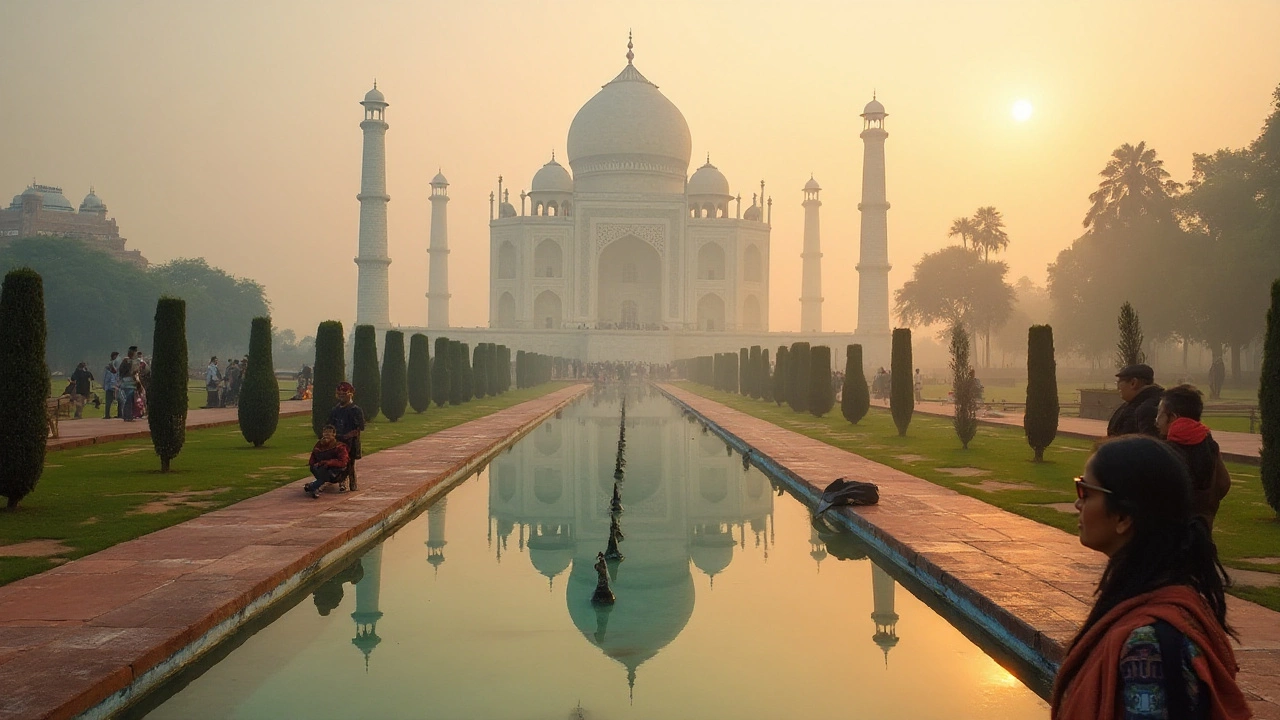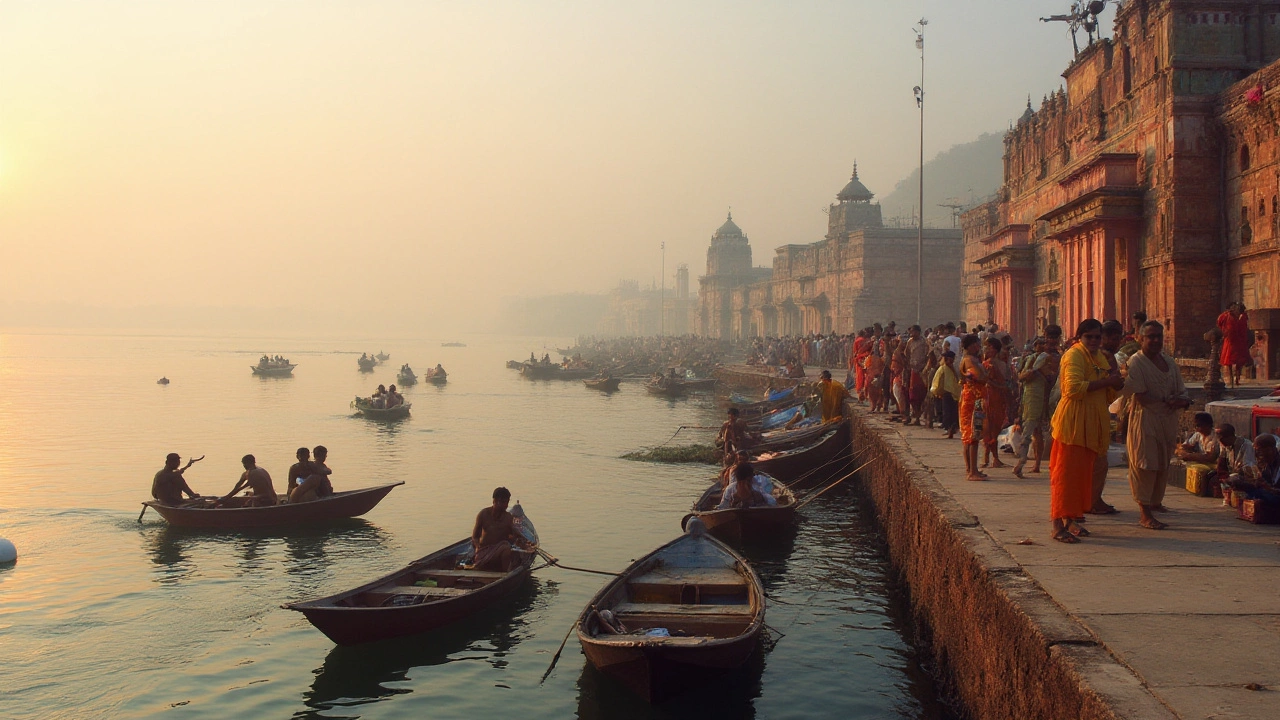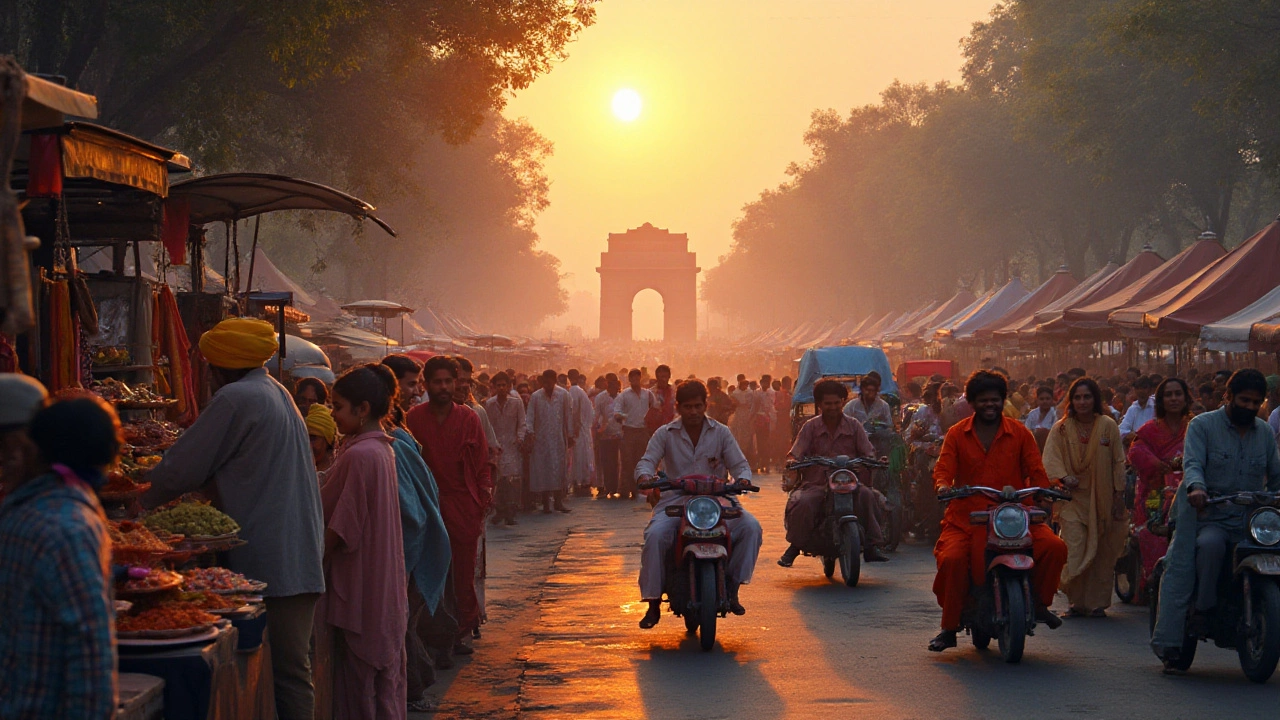When contemplating a journey to India, northern regions almost always find their way onto a traveler's bucket list. Known for its rich cultural tapestry and awe-inspiring architectural marvels, Northern India lures millions of foreigners year after year.
The allure lies not merely in its historic grandeur but in its ability to offer a mosaic of experiences that cater to every whim and fancy. Traditional towns nestled in the Himalayan valleys promise tranquil escape, while vibrant cities like Delhi buzz with activity at every corner.
With spiritual retreats, grandiose palaces, and mouth-watering culinary delights, each corner of the northern expanse offers unique tales waiting to be discovered. Travelers are often drawn to the epic stories and the vivid experiences contained within these lands. So grab your backpacks, and set off on a journey that promises to be both versatile and mesmerizing.
- Iconic Landmarks and Attractions
- Spiritual Retreats and Sacred Cities
- Adventures in the Himalayas
- Cultural and Culinary Experiences
- Travel Tips and Best Practices
Iconic Landmarks and Attractions
Northern India is a treasure trove of iconic landmarks that have left countless visitors in awe. At the pinnacle of this list is the illustrious Taj Mahal, a poetic dedication of love standing majestically on the banks of the Yamuna River in Agra. This UNESCO World Heritage site, built by Mughal Emperor Shah Jahan in memory of his beloved wife Mumtaz Mahal, captivates with its intricate carvings and the ethereal beauty of its marble dome. The Taj Mahal's allure is timeless, with visitors from across the globe often describing it as a symphony in marble.
The bustling city of Delhi, India's vibrant capital, offers a rich tapestry of history and modernity. Among its numerous attractions, the Red Fort stands as a testament to India's historical legacy. Constructed by Emperor Shah Jahan in the mid-17th century, this massive sandstone fortress houses exquisite gardens and fascinating museums. Just a stone's throw away, you can find Qutub Minar, a towering minaret and another iconic UNESCO site. It is a marvel of Indo-Islamic architecture adorned with intricate carvings tracing its storied past.
One cannot discuss Northern India's landmarks without journeying to Jaipur, famously known as the Pink City. Here lies the magnificent Amber Fort, a hilltop gem of Rajasthani architecture. Dominating the landscape with its awe-inspiring ramparts, visitors are often enchanted by its labyrinth of grand courtyards and opulent palaces. The City Palace and Hawa Mahal or the Palace of Winds, with its unique façade, are also a must-see for anyone traveling through this vibrant region.
For those captivated by the spiritual aura of old Varanasi, the ghats along the sacred Ganges River provide a profoundly moving experience. From dawn till dusk, these riverside steps are bustling with pilgrims performing rituals and locals engaging in daily life. A gondola ride at sunrise or sunset offers a view of the city that leaves a lasting imprint on one's soul. Mark Twain beautifully encapsulated the allure of Varanasi, saying, "Varanasi is older than history, older than tradition, even older than legend, and looks twice as old as all of them put together."
The Himalayan town of Amritsar is famed for its stunning Golden Temple, the holiest gurdwara for Sikhs. Known for its golden dome reflecting over the sacred pool of Amrit Sarovar, the temple is a place of worship, community, and unity. The Langar or community kitchen at the temple is one of the world's largest, serving thousands daily. This unique experience showcases the spirit of hospitality and inclusivity inherent to Sikhism.
Visitors drawn to Northern India's historical landmarks will find an area vibrant with stories that stretch back across millennia. These cultural gems not only offer striking visual beauty but also an opportunity to delve into the nation's rich history. A journey through these enchanting sites tells the age-old stories of a land that has witnessed the rise and fall of empires but remains timeless in its allure.
Spiritual Retreats and Sacred Cities
Northern India, a region known for its amalgamation of ancient traditions and spiritual teachings, draws countless foreign visitors seeking tranquility and enlightenment. The sacred cities nestled in these lands are more than just destinations; they serve as spiritual havens that provide solace to seekers from all walks of life. From the meditative echoes of the Ganges in Rishikesh to the evening prayers along the ghats of Varanasi, these places exude a divine energy. Here, travelers find not only a chance to explore ancient religions and philosophies but also an opportunity to dive deep into self-reflection and personal growth.
Rishikesh, often dubbed as the 'Yoga Capital of the World', is a sanctuary for those in search of inner peace and physical well-being. Yoga retreats and ashrams abound, offering classes for practitioners of all levels. The merging of the Ganges with the Himalayan foothills provides an awe-inspiring backdrop to this spiritual haven. Visitors often linger by the riverbanks, participating in the sacred Ganga Aarti, an evening ritual dedicated to the river goddess. This profound atmosphere, combined with the sound of temple bells and the aroma of incense, captivates many, prompting a deeper exploration into both the self and the universe around.
Further east, Varanasi stands as one of the world's oldest continuously inhabited cities. Here, spirituality takes on a vibrant and intricate form. The city, with its labyrinth of narrow streets and myriad temples, is imbued with a palpable sense of devotion. Each morning, pilgrims make their way to the ghats, immersed in the purifying waters of the holy Ganges. The ethereal quality of the city is encapsulated during the pre-dawn hours when the ghats are enveloped in the first light of day. "Varanasi is older than history, older than tradition, older even than legend, and looks twice as old as all of them put together," observed Mark Twain, capturing the spirit that continues to draw soul-seekers.
The Essence of Spirituality
Beyond these iconic cities, towns like Haridwar and Bodh Gaya offer their unique spiritual charms. Haridwar, translating to 'Gateway to God,' holds immense religious significance. It features prominently in Hindu beliefs and folklore, thus becoming a focal point for large religious gatherings and festivals. Bodh Gaya, a little further afield, marks the place where Siddhartha Gautama attained enlightenment under the Bodhi tree, thus becoming Buddha. This site resonates deeply with Buddhist followers from across the globe. Recently, a study indicated that 30% of tourists visiting Northern India specifically venture here for spiritual reasons, highlighting the profound impact these sanctified locations have had and continue to have on international visitors.| City | Significance |
|---|---|
| Rishikesh | Yoga Capital of the World |
| Varanasi | Oldest Living City |
| Bodh Gaya | Buddhist Enlightenment Site |
For travelers planning to explore these spiritual destinations, it's essential to learn about the customs and religious practices. Being respectful of local traditions can significantly enrich the experience. Whether you're attending a ceremonial event in an ashram or witnessing the mystical aura of Varanasi's ghats, the spirit of Northern India leaves an indelible mark on all who traverse its sacred terrain.

Adventures in the Himalayas
The Himalayas have long stood as the gargantuan guardians of India's northern realm, calling out to adventurers with the promise of unparalleled escapades. This vast mountain range is not just about awe-inspiring peaks but offers a cornucopia of thrilling activities that make it a treasure trove for thrill-seekers. As you climb higher and higher, the brisk air, coupled with the breathtaking views, creates a sense of serenity and excitement that’s simply unmatchable. Whether it's trekking along the iconic paths of the Manali-Leh highway or soaring through the skies while paragliding in Bir-Billing, the Himalayas offer a playground for adventurers of every stripe.
Among the most popular activities is trekking, with trails that range from the gentle Kunzum Pass to the challenging Annapurna Circuit. Each path reveals a different facet of nature's beauty and grandeur. Here, the landscape transforms with every step, from lush forests to stark, pine-spiked mountainsides. For those opting for an easier pace, the renowned valley of Kullu captivates with its flowering meadows and sparkling streams. It's also not uncommon to stumble upon rustic hamlets where ancient wisdom about the land is shared freely by the locals.
If trekking doesn’t quite quench your thirst for adventure, then river rafting in Rishikesh should certainly make the itinerary. Known as the gateway to the Garhwal Himalayas, Rishikesh offers the wild, untamed ride down the Ganges, a thrilling experience that will leave you hooked. Paragliding enthusiasts find their haven in Bir-Billing, often labeled as the paragliding capital of India. Adventurers glide over emerald valleys and take in views that are nothing short of heavenly. Moreover, during winter, the adventure takes on an icy twist with skiing and snowboarding on the pristine slopes of Auli. The snow crunches underfoot as one slices through the powdery veil, and the experience of gliding down with the towering Himalayan giants watching over is absolutely exhilarating.
In addition to these thrilling activities, the region also holds an appeal for those seeking a spiritual adventure. The meditative silence of the mountains provides the perfect backdrop for self-reflection and inner exploration. Just as Edmund Hillary once said, "It is not the mountain we conquer but ourselves."
For the nature enthusiast, flora and fauna of the Himalayan region adds another layer of beauty to the forbidden heights. The Great Himalayan National Park in Himachal Pradesh is a UNESCO World Heritage site and supports a staggering variety of biodiversity. From the elusive snow leopard to the colorful Monal pheasant, nature here thrives in its fullness and with such vibrancy it feels almost magical. North India tourism can never be complete without diving deep into these wild terrains, each trek a new story, each camp beneath the star-lit skies a fresh adventure. So, whether it's the call of the mountains, the thrill of the icy trails, or the serene whisper of the woods, the Himalayas promise not only a journey into the landscapes but also a journey within.
Cultural and Culinary Experiences
North India is a tapestry woven with vibrant traditions and diverse flavors, offering tourists a charming journey through its cultural and culinary landscapes. At the forefront of these experiences is the city of Varanasi, often hailed as the spiritual heart of India, where the ancient rituals of Ganga Aarti hold spectators in awe every evening. The ghats of Varanasi, with their timeless mystique, connect travelers to the spiritual heritage that has been cherished for centuries. A walk through the congested yet fascinating lanes of the old city reveals age-old practices and artisans engaged in creating exquisite silk fabrics. No visit is complete without a boat ride at dawn, offering a serene view of the river's endless horizon bathed in the warm colors of sunrise.
Food lovers will find North India to be nothing short of a paradise. The streets of Delhi are a haven for those seeking culinary adventures, with bustling food stalls offering an array of choices that tickle the taste buds. One must not miss the aromatic allure of chaat, with each mouthful delivering an explosion of spicy, sweet, and tangy flavors that embody Delhi's dynamic character. For a touch of royal indulgence, a traditional thali in Rajasthan showcases an opulent selection of dishes like dal baati churma and laal maas, crafted with an intricate blend of spices that evoke the regal past of the region. Amritsar, in Punjab, further complements this culinary journey with its rich and hearty offerings. The famous Amritsari Kulcha with a side of spicy chickpeas and tangy pickles presents a meal that tourists are unlikely to forget.
The sounds, sights, and flavors of North India are steeped in history, a symphony of past and present sounds best experienced in the embrace of its festivals. During Diwali, the Festival of Lights, the entire region transforms into a spectacle of illuminated colors, celebrating the victory of light over darkness. Holi, the Festival of Colors, adds a vibrancy of a different kind, as visitors witness a kaleidoscope of colors worn joyfully by both young and old. Participating in these festivals invites visitors not only to witness but also to partake in the joyous celebrations and cultural harmony shared by people across North India.
According to chef Gagan Anand, "Indian cuisine is like art, and North India is the canvas where bold strokes of flavors meet the spices of life."
For those keen to dive deeper into these rich cultural and culinary experiences, planning visits to key festivals and local culinary hubs can enrich their itinerary. Street food tours, especially in Old Delhi and Amritsar, provide insights into the local diet while offering interactive cooking workshops with indigenous chefs. In Rishikesh, known as the Yoga capital of the world, culinary tourism takes on a health-oriented twist with detoxifying meals and mindful eating practices becoming increasingly popular.
With such a plethora of experiences, the cultural and culinary journey through Northern India captivates the senses, leaving each visitor with tales to tell and flavors to remember. These moments anchor the grand narratives of one's travels and foster a profound connection with the region's rich heritage.

Travel Tips and Best Practices
Embarking on a journey across Northern India can be as thrilling as it is enlightening. To make the most of your travels, there are several useful tips and best practices to keep in mind. For starters, when navigating the bustling cities or serene villages, adapt to the local customs and traditions, which vary significantly across the region. This cultural sensitivity will not only enrich your experience but also garner warmth and respect from the local populace. Consider learning a few basic phrases in Hindi or the dominant regional language to engage with locals more meaningfully. Communication barriers often shrink with just a simple 'Namaste'.
Travelers should pay close attention to their health and safety, which is of paramount importance. Northern India is known for its diverse climates; from the scorching plains to the chilly Himalayan regions, packing accordingly is essential. Layered clothing works well as the temperature can vary greatly from morning to night. Don't forget your trusted hat, sunglasses, and sunscreen for sun protection, especially if you’re exploring the high-altitude regions where the sun’s rays are stronger. Most seasoned travelers recommend carrying a basic first-aid kit and medications for common travel and altitude-related ailments, ensuring you are prepared for any minor mishaps along the way.
Another key tip is to savor and indulge in the vibrant and diverse culinary offerings that Northern India has to provide. However, it's wise to be cautious about street food and raw vegetables; if you decide to try them, seek out stalls frequented by locals which are generally safer options. Staying hydrated is crucial, so opt for sealed bottled water and avoid drinks with ice to minimize the risk of water-borne illnesses. Embrace the local dining etiquette, sharing meals and partaking in traditional methods of eating might seem challenging at first but offer deeper connection with the rich cultures.
When it comes to accommodation, Northern India boasts a range of options from budget hostels to luxury retreats. Consider staying in homestays or smaller boutique hotels that offer personalized services and cultural immersion experiences. Booking in advance is advised, especially during peak tourist seasons, as popular locations can get booked out quickly. Transportation is an important aspect to consider in your travels. The Indian train network is vast and comprehensive, offering a unique and scenic way to traverse the northern landscapes, but ensure you book tickets early for confirmed seats. For intercity travel, consider hiring private taxis from reputable providers to explore places at your own pace.
Lastly, respecting the environment and contributing positively to the communities you visit is a lasting legacy we should all aim for. Bringing reusable water bottles, shopping bags, and minimizing waste helps maintain the stunning beauty and ecological balance of Northern India. Engage in ethical tourism practices by supporting local artisans and avoiding activities that could harm wildlife or exploit people. In the words of travel enthusiast Paul Theroux, "Traveling is not just seeing the new; it is also leaving behind." By following these tips, your journey through Northern India promises not only to be an adventure but a responsible and memorable experience.
